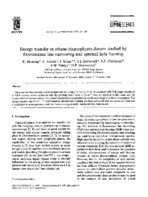Energy transfer in ethane-bisporphyrins studied by fluorescence line narrowing and spectral hole burning
| dc.contributor.author | Mauring, K. | en |
| dc.contributor.author | Suisalu, A. | en |
| dc.contributor.author | Kikas, J. | en |
| dc.contributor.author | Zenkevich, E. I. | en |
| dc.contributor.author | Chernook, A. V. | en |
| dc.contributor.author | Shulga, A. M. | en |
| dc.contributor.author | Gurinovich, G. P. | en |
| dc.date.accessioned | 2017-05-18T18:32:48Z | |
| dc.date.available | 2017-05-18T18:32:48Z | |
| dc.date.issued | 1995 | |
| dc.identifier.citation | Energy transfer in ethane-bisporphyrins studied by fluorescence line narrowing and spectral hole burning / K. Mauring [et al.] // Journal of Luminescence. – 1995. – Vol. 64. – P. 141-148. | en |
| dc.identifier.uri | https://rep.bntu.by/handle/data/30018 | |
| dc.description.abstract | The quasi-line fluorescence excitation spectrum of 1,2-bis (2,3,7,8,12,13,17,18-octaethyl-21H,23 H-porphino) ethane at 4.8 K consists of two subbands with the splitting mean value of 51cm⁻¹, that are ascribed to the donor and the acceptor half of the homodimer. The donor's fluorescence is quenched by an efficient energy transfer to the acceptor. The energy transfer rate of 10¹¹ s⁻¹, determined by spectral hole burning, has been compared with the calculated value and a conclusion of nonconsistency with the Forster energy transfer mechanism has been drawn. | en |
| dc.language.iso | en_US | en |
| dc.title | Energy transfer in ethane-bisporphyrins studied by fluorescence line narrowing and spectral hole burning | en |
| dc.type | Article | ru |
| dc.identifier.doi | 10.1016/0022-2313(95)00023-j |

